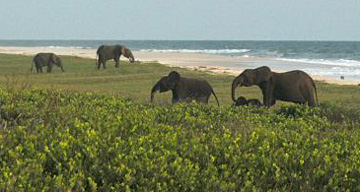
The previous post on the oil exploration in the Virungas made me realize I never posted about Luisa Rabanal's (and colleagues) amazing paper on the impact of oil exploration in Loango National Park -MA
The impact of seismic oil exploration on rainforest wildlife
From Conservation Maven.com
by ROB GOLDSTEIN
A new study looks at the impact of seismic oil exploration on wildlife in Gabon's Loango National Park. Luisa Rabanal and fellow researchers found evidence that the loud noises generated by oil exploration activities can cause elephants to move large distances to escape the disturbance. The study findings also indicate that seismic activities can cause smaller scale disturbances for gorillas.
In threatened species like African forest elephants that have few offspring and mature slowly, disturbances that cause large scale shifts in spatial distribution may negatively affect the health of populations. According to the authors, this is the first study they know of to quantitatively assess the impact of noise from seismic activities on rainforest mammals.
Oil development activities in rainforests have raised a number of deep concerns about social and ecological impacts. During seismic oil exploration, dynamiting and other human activities can generate extremely loud noises - up to 210 decibels next to the explosion site or 10,000 times louder than a jet aircraft flying by at 300 m altitude.
The researchers surveyed elephants, gorillas, chimpanzees, duikers, and monkeys in Loango National Park over a 6-week period of dynamiting in 2007. They used modeling to detect impacts to wildlife distribution at large, intermediate, and small scales.
The researchers hypothesized that large wildlife like elephants, gorillas, and chimpanzees with expansive home ranges would experience large-scale disturbance. They also hypothesized that smaller wildlife like monkeys with limited ability to disperse large distances would experience small scale disturbance - i.e. dynamiting would just cause them to move short distances during the period of the activity.
While the study found large-scale impacts in elephants, they only found medium and small-scale effects in gorillas. The weaker than expected impacts on species distribution may have been due to the fact that the oil exploration activities were actually much less invasive then they could have been.
Environmental organizations commissioned by the Gabon government audited the activities to enforce certain agreed upon best practices to minimize disturbance to wildlife - for example, no chainsaws were permitted and dynamite had to be placed at least 6 meters deep. So seismic activities in other cases without rigorous environmental standards might cause much worse impacts.
The researchers also warn that seismic activity may cause other negative impacts to species unrelated to habitat use. They write,
"Our results may also suggest that the apes were even more disturbed by the explosions if they were unable to move larger distances and hence we stress the need for other methods of examining the seismic impact such as hormone and physiological measures. This also applies to certain species whose movements are restricted by their ranging patterns (e.g. duikers) where stronger responses may be exhibited through physiological mechanisms such as increased stress levels and/or reduced reproductive output"---
Reference:
Rabanal L, Kuehl H, Mundry R, Robbins M, Boesch C (2010) Oil prospecting and its impact on large rainforest mammals in Loango National Park, Gabon Biological Conservation 143(4): 1017-1024 DOI: 10.1016/j.biocon.2010.01.017
Abstract
Resource extraction is increasingly affecting protected areas worldwide. However, aside from studies on logging, limited information is available about the effect this has on wildlife, which may be of great consequence, especially when endangered species could be affected. Specifically, the effect of intense human-induced noise during oil exploration on wildlife is poorly understood. We explore the effect of seismic oil exploration on large mammal distribution in an 80 km2 area of Loango National Park, Gabon. Following the ecological theory of habitat disturbance, we predicted that changes in habitat use in response to noise disturbance would scale with the body/home range size of each species examined. Our study was conducted over six months before, during and after low-impact seismic operations. We recorded counts along transects of indirect signs of elephants (Loxondota africana cyclotis), chimpanzees (Pan troglodytes troglodytes), gorillas (Gorilla gorilla gorilla), duikers (Cephalophus spp.), and the vocalizations of five monkey species (Cercocebus torquatus, Cercopithecus cephus, C. nictitans, C. pogonias and Lophocebus albigena) and modeled seismic impact over different spatial scales (small, intermediate and large). We found that elephants avoided seismic activity on all three spatial scales, apes avoided on the intermediate and small scales, and there was no effect for duikers and monkeys. We conclude that low-impact seismic operations can cause considerable temporary habitat loss for species with large ranges and suggest that the impact on those endangered species can be minimized by adequately spacing seismic lines and activity in space and time to enable species to move away from the progressive noise disruption.







1 comment:
thank you so much for this great informations !! good work
Post a Comment